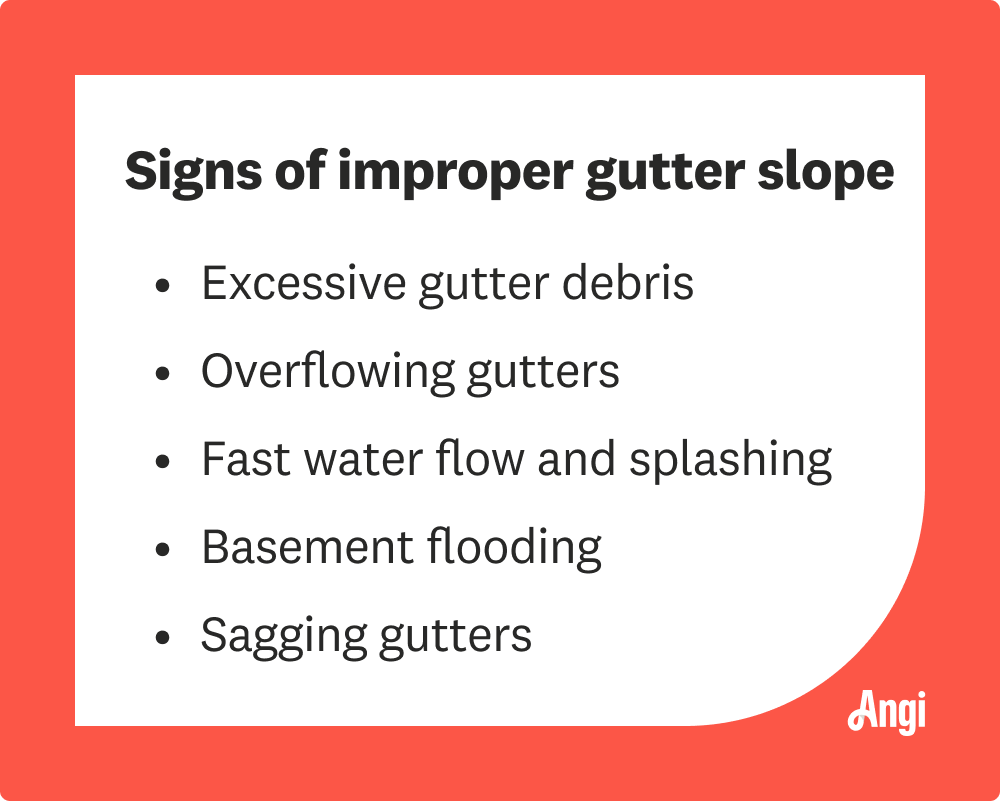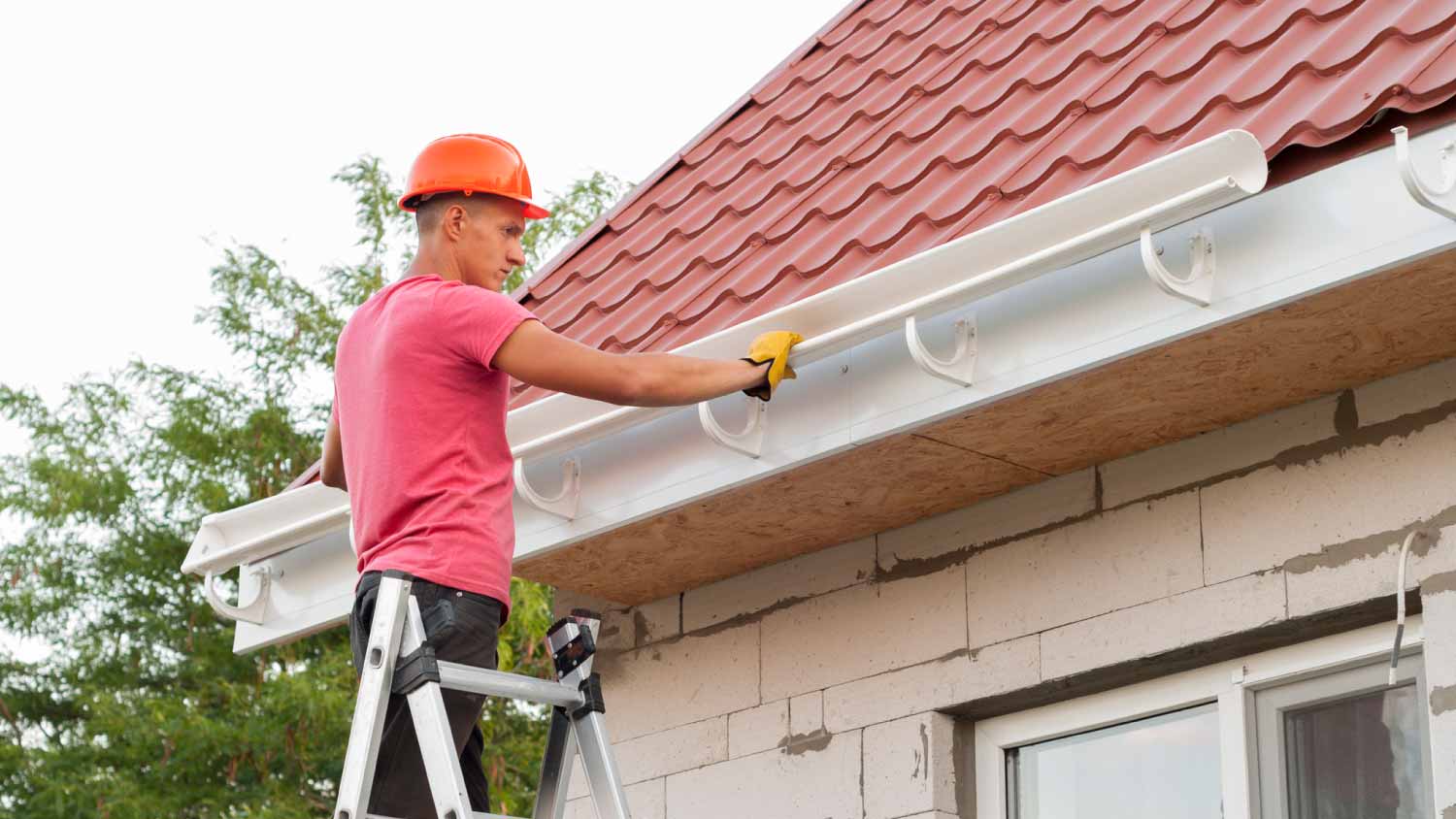
This guide will give you an idea of how much you can expect to pay when getting new seamless gutters installed when accounting for removal, labor, and different gutter materials.
This guide to gutter slope will help you minimize your home's splash factor


Improper gutter slope causes clogging and overflow.
Visual inspection can usually confirm bad gutter slope.
If your gutters aren't working properly, your home is at risk for mold, mildew, flooding, and a cracked foundation.
Fixing your gutters as soon as you notice the problem is a lot cheaper than replacing a damaged gutter system.
Local gutter pros can easily realign your gutters.
The rules of gutter slope are important to homeowners who don't want to deal with messy spillover. Do you know if your gutters have enough of a slant to prevent a splash? This guide to why gutter slopes matter spills it all out to help you avoid big spills that can harm your home's foundation.
Also known as gutter pitch, gutter slope describes the amount that gutters slant downward along the natural path of water flow against the house. Your home's gutters are installed horizontally across the face of your fascia board. They are typically angled toward one of the downspouts located on either the left side or right side of the system. The goal is for water to easily drain toward the chosen downspout.
While gutter slope is essential for the proper function of your gutter system, an abnormal slope can also look "off."


Gutter slope is important because the whole point of a gutter system is to allow water to flow away from your home via the downspout. When slope is on point, water will flow at the right pace to prevent buildup of old and new water. Gutter slope also prevents debris from getting caught in place.
When gutters don't have enough of a slope, water will pool in your gutters. In heavy rains, water will fill your gutters faster than old water can drain out. This is where you get a clogged, inefficient gutter system with spillover.
A slope that's too severe can also cause problems. The telltale sign of an exaggerated gutter pitch is splashing in heavy rain that's caused by water moving too quickly.
When there's not enough of a gutter slope, you're likely to end up with clogged gutters that become home to mold, mildew, and debris. Additionally, your gutter system is likely to sag under the weight of pooling water that can't find its way to the downspout.
It's also common for clogged gutters to direct water into your basement instead of moving it away from your home. When this happens, you can get flooding and water leaks that affect your home's foundation. Over time, this can create a crack in the foundation that greatly compromises the structure of your home.
The splashing effect caused by a slope that's too severe can also damage a home's foundation in a similar way.
Poor gutter slope also puts your roof at risk because water that isn't properly diverted downward can pool until it leaks into the home's roofing, fascia, and frame. This creates big rot and mildew risks that create an unhealthy home.
Finally, poorly functioning gutters can actually cause damage to your walkway and driveway. Water that gets improperly diverted to these areas will cause shifting that ultimately leads to crumbling and cracking. While not as devastating as the rot that can affect your home, broken concrete can be expensive to repair or replace.
The general consensus is that gutter slope should be a maximum of 1/4 inch for every 10 feet of gutter. Downslopes should be placed every 30 feet within a gutter system. Here's how to measure gutter slope:
Run a piece of string from where an end cap will be placed to where a downspout will go. This is the length of the guttering.
Next, lower the end of the string on the downspout side no more than 1/4 inch for every 10 feet.
Use chalk to make a line along the roofline to show where the gutters will be mounted.
Repeat the process for the full length of the gutter system.
If you suspect that your existing gutter pitch is wrong, you'll need to get up to the gutter with a level to confirm if it's pitched correctly. Signs that something is off with gutter pitch include pooled water, sludge coming off your gutters, gutter overflow, or visible tilting of the gutters from the ground level. Hopefully, you're taking advantage of the affordable gutter cleaning cost to stay ahead of any of these issues before they catch you by surprise.
You can save a ton on gutter replacement cost by getting your gutters at the right pitch before the whole system fails from the weight of water and debris.
However, realigning gutters is a complicated process that requires you to climb up to your roofline to remove all gutter brackets and spikes. You'll then manually reset the gutter using hidden hangers. Finally, you'll need to confirm that the new pitch is correct.
Teaching yourself how to realign gutters if you don't already have knowledge of how to install gutters can be challenging. What's more, you risk voiding the warranty on your gutter system if you hang your gutters improperly. There's also a risk that you will damage your roof or siding while nailing gutters back into place. The good news is that local gutter installers will be able to come out to confirm that your gutter pitch is off before providing solutions for correcting your alignment.
From average costs to expert advice, get all the answers you need to get your job done.

This guide will give you an idea of how much you can expect to pay when getting new seamless gutters installed when accounting for removal, labor, and different gutter materials.

Gutter repair costs may not be as high as you think—but it depends on the type of damage you're addressing. Learn why you need to hire a gutter pro for this work.

Learn about the average cost of zinc gutters when having new gutters installed at your home. Long-lasting zinc gutters can cost twice as much as aluminum gutters.

Discover galvanized steel gutters installation cost, including average prices, key cost factors, and tips to save on your gutter project.

Underground downspouts drain water away from your home, but can become clogged. Learn how to locate underground downspouts in this guide.

If you suspect your gutters have damage and need repair, it may be time to consider a gutter replacement. Find out how often you should replace your gutters, and the signs of bad gutters.